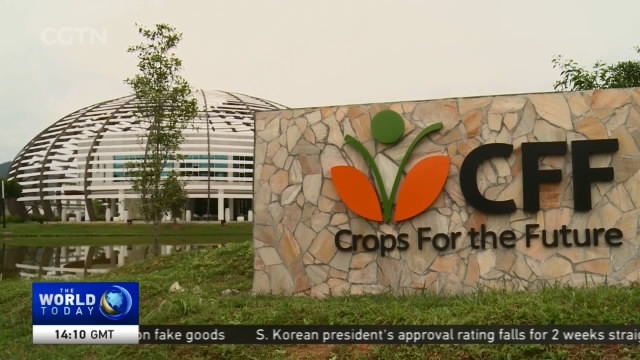
22:27, 18-Jan-2018
Forgotten Foods Research: World over-reliant on handful of food crops

Here's a startling statistic: Just four food crops – wheat, soya, maize and rice – supply half of the world's total food needs. Yet over the course of history, humans have grown something like seven-thousand crops. Most of them are now long forgotten or grown in small quantities. But researchers at a centre in Malaysia believe some of these forgotten foods could help to sustain humanity in the future, especially in the face of a changing climate. Rian Maelzer visited the Crops for the Future centre just outside Kuala Lumpur, and serves up this story.
These climate-friendly domes house Crops for the Future, a centre seeking out and researching non-major food crops of the world in partnership with the University of Nottingham and the Malaysian government.
PROF. SAYED AZAM-ALI CEO, CROPS FOR THE FUTURE "The whole point of CFF is to provide viable, credible alternatives that have commercial and market potential. We have to make uses of these plants and make them into products that people will buy and consume and cherish. Those are the plants that we no longer see in supermarkets. We don't see products from them. But we have memories of them. Let's go back and look at some of those and test them. If we can test them and see which of those foods and nutrition and products we can get from them will be suitable because the crops that they come from would be the crops that we can see as being climate resilient crops."
One promising example is the Bambara groundnut, which can grow in poor, acidic soils.
PROF. SAYED AZAM-ALI CEO, CROPS FOR THE FUTURE "And it makes nutritious products that actually communities would eat if we could present it in a form that people want to buy."
Another is moringa.
RIAN MAELZER SEMENYIH, MALAYSIA "The moringa tree produces this vegetable widely known as the drumstick. What is less well known is that its leaves are packed full of vitamins and minerals."
Late last year, Britain's Prince Charles launched a new CFF initiative, the Forgotten Foods Network. It's a web-based platform seeking out people to share recipes from their past, then testing them for their nutritional value and commercial potential. The quest started with CFF staff.
JANAKI GOVARAN CUSTOMER SERVICE ASSISTANT, CFF "The name of the food is Kevaru roti, which is made from finger millet and was introduced to me by my grandma at the age of seven. I used to help her harvest this finger millet and help her grind it."
"Mmm, sweet, a bit cocunutty. I'd eat this for breakfast.”
PROF. SAYED AZAM-ALI CEO, CROPS FOR THE FUTURE "All those ingredients that we have forgotten about, we want to resurrect and test and use to rediscover these forgotten foods. And then from that take recipes and products and foods that we can actually put forward as foods for the future."
A future of increasing rural to urban migration, population growth and climatic upheaval that will demand new solutions to meet the world's nutritional needs. Rian Maelzer, CGTN, Semenyih, Malaysia.

SITEMAP
Copyright © 2018 CGTN. Beijing ICP prepared NO.16065310-3
Copyright © 2018 CGTN. Beijing ICP prepared NO.16065310-3